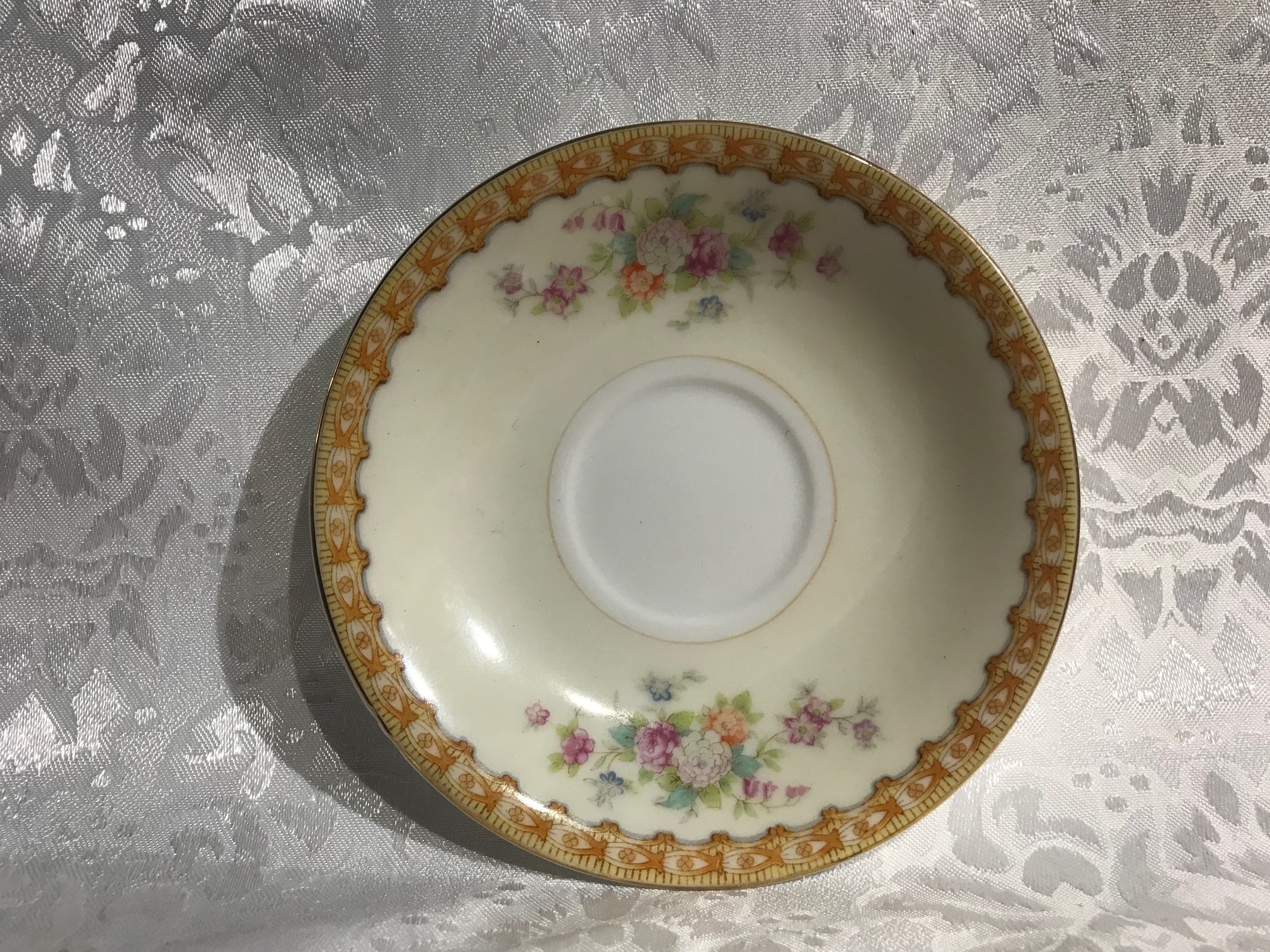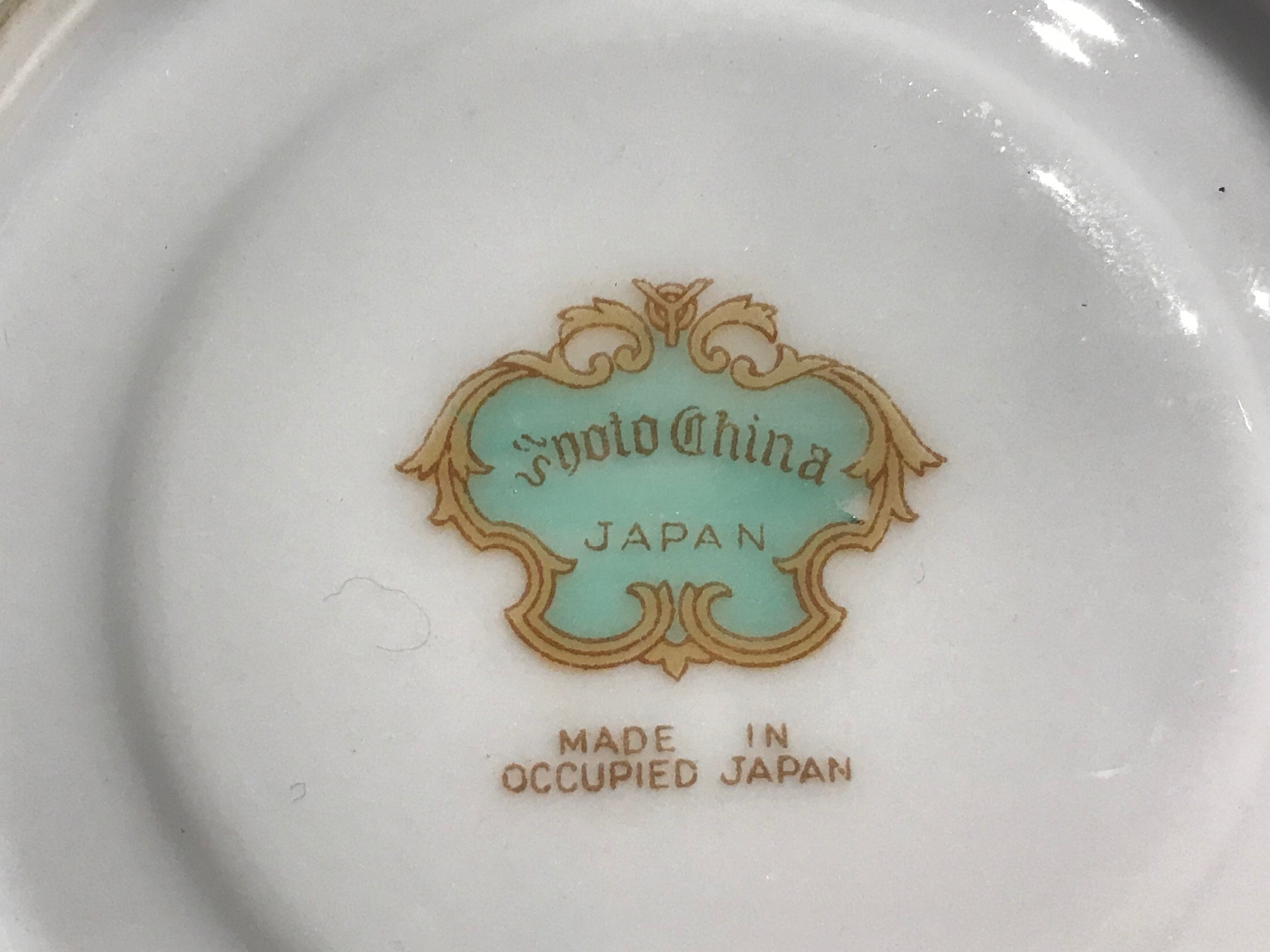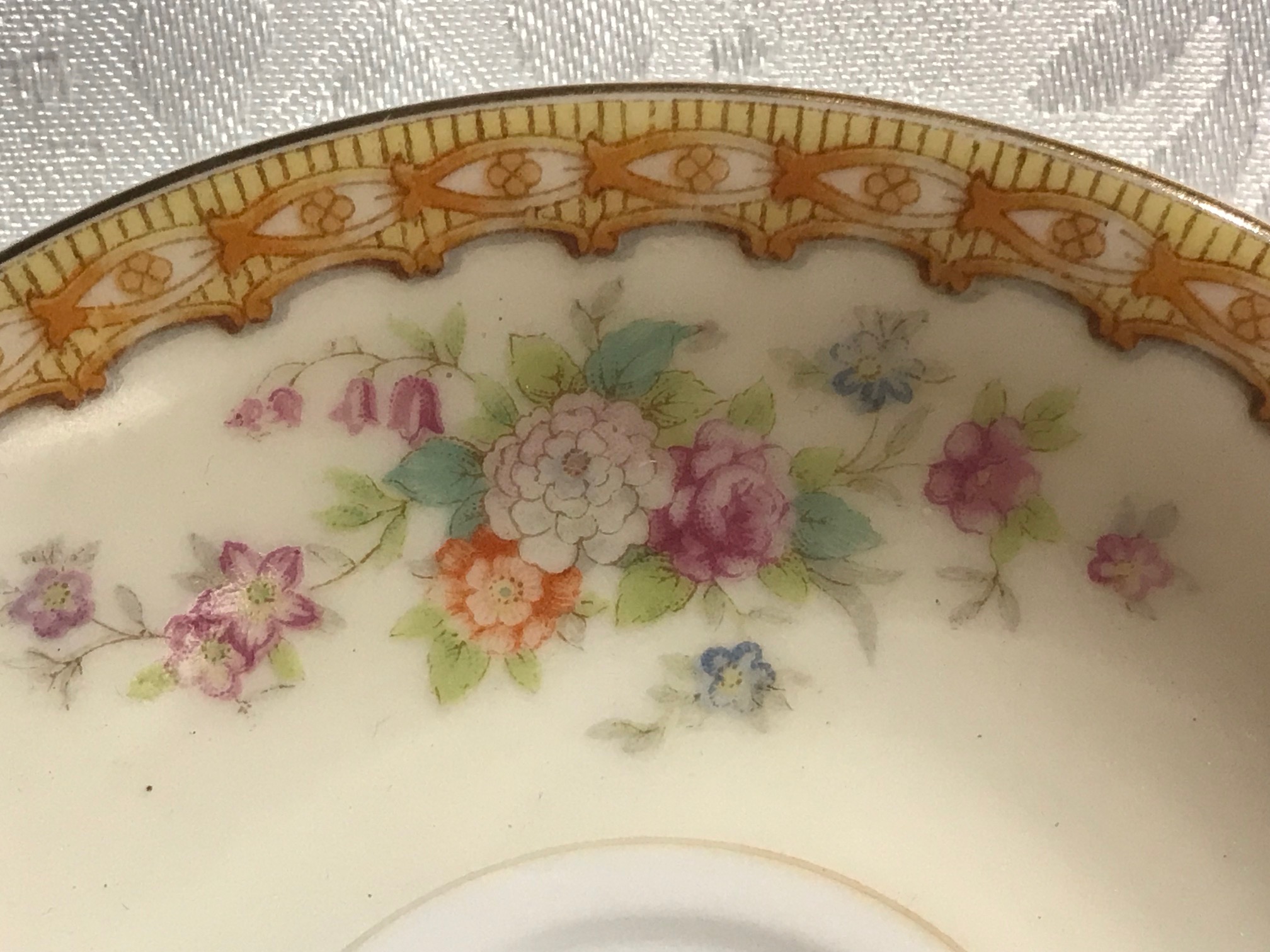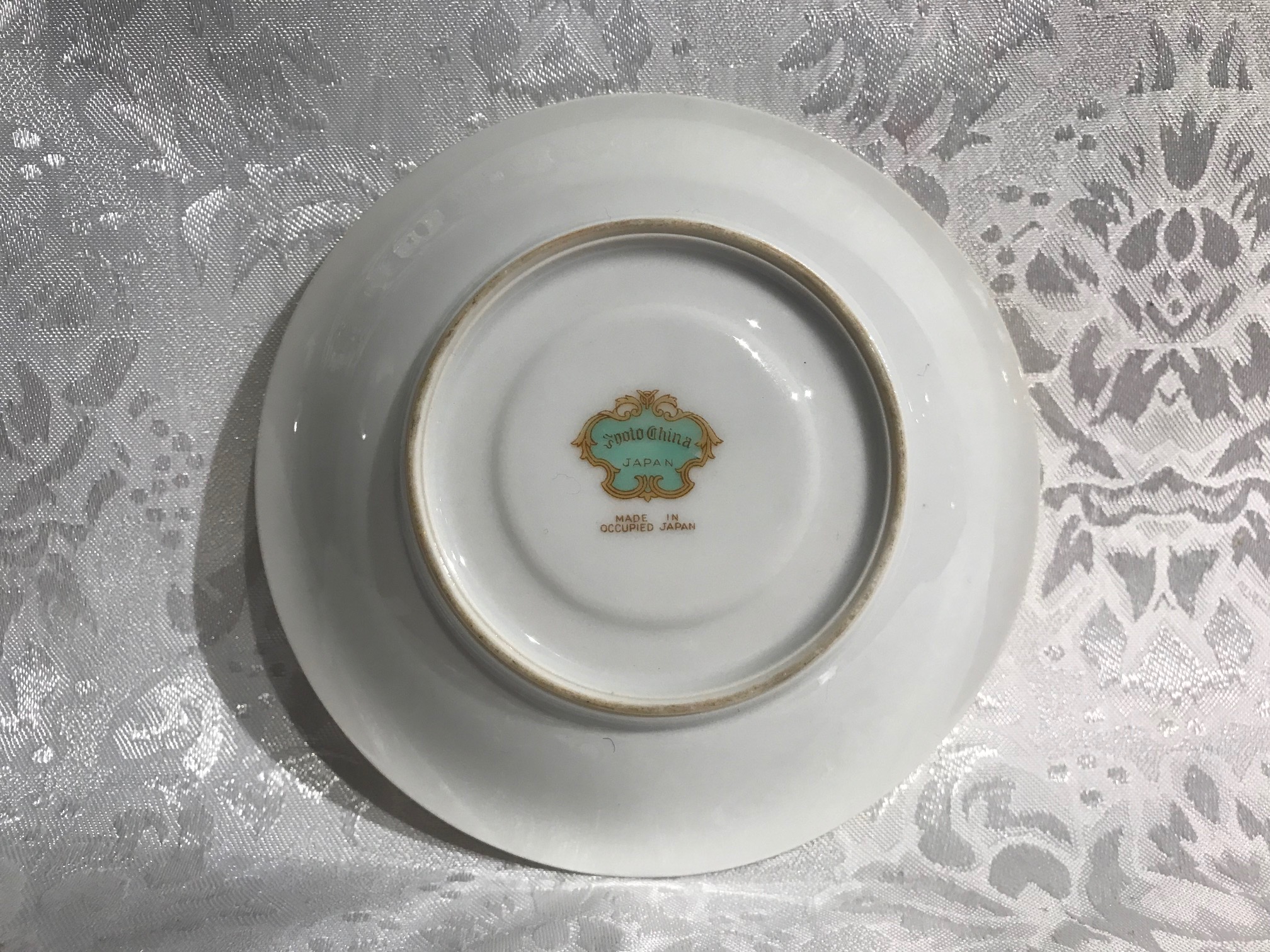Made in Occupied Japan floral saucer: positive for Lead (6,825 ppm), Cadmium, Arsenic (878 ppm) and Antimony.
 The back mark with the words “Made in Occupied Japan” puts the date of manufacture of this dish in the range of 1945 to 1952. When tested with an XRF instrument the small floral design saucer pictured here had the following readings:
The back mark with the words “Made in Occupied Japan” puts the date of manufacture of this dish in the range of 1945 to 1952. When tested with an XRF instrument the small floral design saucer pictured here had the following readings:
Food surface of the dish – on the flowers:
- Lead (Pb): 6,208 +/- 160
- Cadmium (Cd): 24 +/- 8
- Chromium (Cr): 543 +/- 87 ppm
- Tin (Sn): 47 +/- 16 ppm
- Zinc (Zn): 745 +/- 58 ppm
- Iron (Fe): 2,890 +/- 248 ppm
- Vanadium (V): 112 +/- 27 ppm
- Titanium (Ti): 212 +/- 40 ppm
Food surface of the dish – on the yellow edge:
- Lead (Pb): 6,825 +/- 140
- Arsenic (As): 878 +- 69 ppm
- Barium (Ba): 942 +/- 198 ppm
- Chromium (Cr): 141 +/- 76 ppm
- Antimony (Sb): 110 +/- 49 ppm
- Tin (Sn): 101 +/- 35 ppm
- Gold (Au): 150 +/- 23 ppm
- Zinc (Zn): 808 +/- 34 ppm
- Nickel (Ni): 26 +/- 16 ppm
- Iron (Fe): 2,660 +/- 104 ppm
- Bismuth (Bi): 110 +/ 42 ppm
Food surface of the dish – on the white center:
- Cadmium (Cd): 18 +/- 7 ppm
- Iron (Fe): 2,058 +/- 222 ppm
- Bismuth (Bi): 64 +/ 13 ppm
- Vanadium (V): 116 +/- 24 ppm
- Titanium (Ti): 221 +/- 35 ppm
NOTE: If you can make out the name of the brand of this china please let me know. I cannot tell if the first character is a letter or some sort of symbol!
Continue reading below the image.
Test results reported on this blog are science based, accurate and replicable. Unless otherwise noted, each test result reported here was for testing done for a minimum of 60 seconds with a freshly calibrated XRF instrument (repeated multiple times to confirm the levels of metals found.) Metals not detected by the XRF instrument in “Consumer Goods Mode” are not listed in the test results set above. Said another way – all metals detected by the XRF instrument (testing in Consumer Goods mode) are listed above – for each surface tested.
How is Lead allowed in dishes?
Why is this legal?
While dishes are not currently regulated for total Lead content as detectable with an XRF instrument, a comparable and relevant standard to consider in evaluating Lead-safety in dishes is the United States Consumer Product Safety Commission standards for toys and other items used by children (standards implemented with the Consumer Product Safety Improvement Act of 2008.) As a result of this relatively new set of regulatory standards, items are considered safe for use by children as long as they fall below 90 ppm Lead in the paint, glaze or coating (and below 100 ppm Lead in the substrate.) Dishware is exempt form this regulatory standard unless it is a set of dishes expressly made and marketed to be used by children (like a set of baby dishes.) The government / industry “thinking” here (read: “exploited regulatory loophole”) is that “dishes are not intended for use by children.”
Total Lead content standards (as detectable using XRF technology) are separate and distinct from leach testing standards. Leach testing standards are the only current standards for dishware made to be used by adults. Current/modern Leach testing standards are outdated and not protective of human health. You can read more about the limitations of leach testing standards (and why they put human health at risk when dishes are used as intended) here on this related post.
So how does this dish rate, overall?
Would you use it in your home Tamara?
I would never use a dish like this given the very high level of Lead in the food surface of the dish. I cannot tell you how many times readers have said to me “…but I make sure my food doesn’t touch the decorative edge…” – a statement which I find ridiculous as it would be impossible to do (or if you achieved that goal – of the food not touching the edge – it would take a considerable amount of effort each time you ate – and would still not likely be a successful initiative!) I personally prefer to err on the side of caution and use completely Lead-free dishes in my home. Here’s my Amazon affiliate link* to the exact dishes I use every day in my home (a style and brand of dishes I have tested repeatedly over the years and found to be Lead-free – in the plain white options only): https://amzn.to/2NwxTJ1 [If you are interested in purchasing the dishes I use in my home, check the prices at Target before purchasing them on Amazon – as Target may have a better price.] Here’s a link to a post with some simpler (not as decorated and therefore less expensive) versions of the dishes I use in my home as well.
As always, thank you for reading and sharing my posts.
Please let me know if you have any questions.
The testing I report on here on my blog is a collaborative effort with the support of my readers. If you are interested in participating in this testing, please click here for more information about how that works.
Tamara Rubin
#LeadSafeMama
*Amazon links are affiliate links. If you purchase something after clicking on one of my links I may receive a small percentage of what you spend (usually 4 to 6%) at no extra cost to you. 
Never Miss an Important Article Again!
Join our Email List



 The back mark with the words “Made in Occupied Japan” puts the date of manufacture of this dish in the range of 1945 to 1952.
The back mark with the words “Made in Occupied Japan” puts the date of manufacture of this dish in the range of 1945 to 1952. 


I have several variations of this pattern; it was my grandmother’s china and I inherited it. I believe the brand name is Kongo; the pattern names are different numbers but it was easy to mix and match the set. Sometimes Replacements.com can be helpful in finding pattern names. needless to say, these dishes are going away. We used to eat off of them for special occasions, but no more!
Hi Stephanie!
Thank you so much for commenting with additional information. I will update the post as soon as I have a moment. I also want to say how much I appreciate it when readers actually take the time to read what I write! You cannot know how often I hear “Oh I just read what I saw on Facebook” (which means they only read the headline!)
Have a Lead-safe holiday season!
Tamara
I was able to find many patterns under the name of “Jyoto China”! I was surprised because the label is tough to read. I also found this brands logo listed under Noto, Jnoto, Poto, Jpoto, Jpato & there could be many other misspelled listings on the internet. Jyoto China seemed to have the most pattern photos and listings for sale. Hope this helps someone. I also have an old set that I have never eaten off of due to my feeling that it contained toxins. So, this article was helpful in setting my mind at ease. Pretty things can be deadly! Enjoy.
I have some bone china tea cups that I bought a couple of years ago. Are all those also contain high amounts of lead? They are not antiques, but they come from China.
~Blanca.